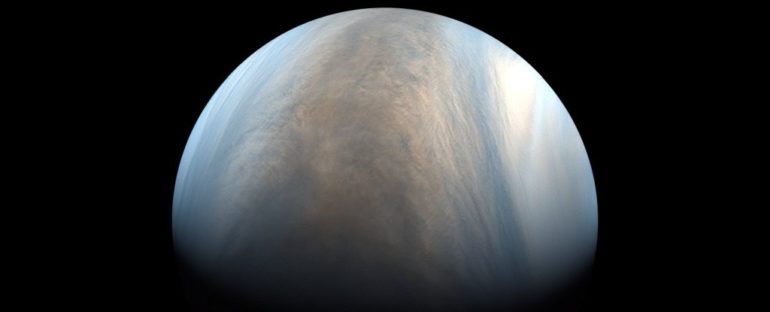Phosphine gas detected in the atmosphere of Venus could have a volcanic origin after all, new research has found.
An analysis of potential volcanic activity on the mysterious planet has found that, contrary to findings uploaded to preprint server arXiv last year, there may indeed be sufficient geothermal venting to produce the detected abundances of the gas.
The detection of phosphine on Venus, announced in September of 2020, had scientists around the world shaken.
The gas can be found here on Earth in very limited contexts, one of which is anaerobic, or low oxygen, ecosystems. It’s found in swamps and sludges, where anaerobic microbes thrive; it’s found in intestines and intestinal gas. Somehow, anaerobic microorganisms produce phosphine – and the clouds of Venus are anaerobic.
As we reported at the time, however, a biological origin was far from the only possible explanation. One phosphine-producing process here on Earth is volcanic activity. And while the team ruled this out, finding that volcanic activity on Venus is insufficient and citing a 2015 study on the matter, more recent research indicated Venus may be more volcanically active than previously thought.
Now scientists from Cornell University have made a careful study of the available information, and concluded that volcanic activity, particularly explosive volcanic activity, could have produced the observed abundance of phosphine.
“The phosphine is not telling us about the biology of Venus,” said astronomer Jonathan Lunine of Cornell University. “It’s telling us about the geology. Science is pointing to a planet that has active explosive volcanism today or in the very recent past.”
The path of the phosphine detection has not been smooth. Initially, the abundance, made using two separate instruments at two different times (the James Clerk Maxwell Telescope in 2017 and the Atacama Large Millimeter/submillimeter Array in 2019) was determined to be about 20 parts per billion.
Then, it turned out there had been an error processing the data from ALMA; the reprocessed data yielded a lower abundance, a global average of 1 to 4 parts per billion, with localized peaks of 5 to 10 parts per billion.
Lunine and his colleague, geologist Ngoc Truong of Cornell University, have reviewed Venus data suggesting active volcanism – if not current, then recent. They used published laboratory data on the production of phosphine gas to determine if a form of phosphorus called phosphide vented from deep under the Venusian mantle could be converted into phosphine.
Here on Earth, phosphorus found in impurities in iron can be converted efficiently to phosphine gas via reactions with hydrochloric acid, and magma rich in phosphide can be found deep in the mantle.
The researchers assumed a Venus mantle oxidation state similar to Earth’s – not unreasonable, given that the two planets are so similar in mass and composition, if not habitability. And they found that, if vented by way of explosive volcanism, phosphide in Venusian magma can be converted into phosphine via reactions with the sulfuric acid in Venus’ atmosphere.
Surface features on Venus are suggestive of recent volcanism; sulfur dioxide, a gas that can be volcanogenic, has been detected in the Venusian atmosphere. Using these and other studies, the researchers found there can indeed be sufficient volcanic activity on Venus to produce the observed abundances of phosphine.
Of course, the phosphine detection itself is still the subject of a lot of debate and is yet to be confirmed by another instrument (you can read more about that here). The new study doesn’t address that, but simply lays out the case for another means by which the phosphine could have come to be there.
“Given the ongoing debate about the robustness of the phosphine detection itself, our results only suggest a roadmap to assessing the level of Venusian volcanic activity today,” the researchers wrote in their paper.
“Should the phosphine be there, it might point to Venus experiencing a modestly elevated epoch of active plume volcanism with magma originating deep in the mantle. That, in turn, would strengthen the case for additional missions to understand the geologic state and history of the planet closest to us in space and bulk physical properties.”
The research has been published in PNAS.


